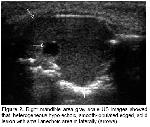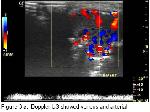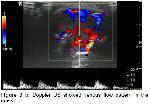Giant cell granuloma is a relatively uncommon benign tumor of the oral cavity. Approximately 70 % arise in the mandible. Lesions are more common in the anterior portion of the jaw, and mandibles lesions frequently cross the midline
4.
The clinical behavior of GCG ranges from a slowly growing a symptomatic swelling to an aggressive lesion that manifests with pain, local destruction of bone, root resorption, or displacement of teeth. Aggressive subtypes of GCG have a tendency to recur after excision5. The histological features of GCG have been extensively discussed6 and it is defined by the World Health Organization as an intra osseous lesion consisting of cellular fibrous tissue that contains multiple foci of hemorrhage, aggregations of multinucleated giant cells, occasionally, trabeculae of woven bone7.
A number of conditions can present with lesions that histological are indistinguishable from the GCG of bone, including brown tumors of hyperparathyroidism, cherubism, and, less commonly, a number of inherited syndromes including Noonan syndrome, neurofibromatosis type-1. Brown tumors of hyperparathyroidism are osteolytic lesions of bone that result from excessive parathyroid hormone secretion. Radiographic findings are also characteristic. Besides multiple lytic lesions of bone, when these occur intraorally there is a loss of the lamina dura adjacent to the roots of the teeth and an altered trabecular pattern in the tooth-bearing areas of the jaws. Multiquadrant radiolucent lesions of the jaws characterize cherubism, an autosomal dominantly inherited condition with variable expressivity. Dental findings include marked displacement of developing second and third molars as well as premature exfoliation of primary teeth. Marked cervical lymphadenopathy is common.
The radiological features of the GCG have not been clearly defined, and conflicting descriptions appear in various textbooks and articles8. In panoramic radiography, the lesion may appear as a unilocular or multilocular radiolucency, with well-defined or ill-defined margins and varying degrees of expansion of the cortical plates. US may have information about the size or shape of the lesion, and also venous and arterial blood flow pattern in the mass. But anyway it is important to remember that the radiological appearance of the lesion is not pathognomonic and may be confused with that of many other lesions of the jaws9. GCG of the jaws, especially smaller lesions, are commonly treated by surgical curettage. Aggressive lesions are occasionally treated by en bloc surgical resection.
In conclusion GCC clinically results in some difficulties in differential diagnosis, US may have information about the size or shape of the lesion, and also venous and arterial blood flow pattern in the mass so US examination may be a suitable diagnostic approach. Anyway confident diagnosis can be performed with histopathological examination.






